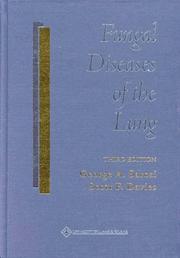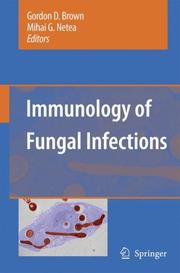| Listing 1 - 10 of 63 | << page >> |
Sort by
|
Book
ISBN: 183969419X 1839694181 Year: 2022 Publisher: London, England : IntechOpen,
Abstract | Keywords | Export | Availability | Bookmark
 Loading...
Loading...Choose an application
- Reference Manager
- EndNote
- RefWorks (Direct export to RefWorks)
Mycoses. --- Fungal diseases --- Fungal infections --- Fungous diseases --- Mycosis --- Mycotic diseases --- Mycotic infections --- Medical mycology
Book
ISBN: 1838804692 1838804684 1838807616 Year: 2019 Publisher: IntechOpen
Abstract | Keywords | Export | Availability | Bookmark
 Loading...
Loading...Choose an application
- Reference Manager
- EndNote
- RefWorks (Direct export to RefWorks)
This book aims to provide readers with some of the current trends in mycology. Its chapters include discussions on the major invasive fungal diseases, host-pathogen interactions, relationships between fungal growth and the environment, the use of fungal species to control soil parasites, and the antifungal properties of thiosulfonates. The information herein covers topics in mycological research and will be of interest to students and researchers in all biological sciences.
Mycoses. --- Fungal diseases --- Fungal infections --- Fungous diseases --- Mycosis --- Mycotic diseases --- Mycotic infections --- Medical mycology --- Medicine --- Internal Medicine --- Infectious Diseases --- Health Sciences
Periodical
Abstract | Keywords | Export | Availability | Bookmark
 Loading...
Loading...Choose an application
- Reference Manager
- EndNote
- RefWorks (Direct export to RefWorks)
Mycoses --- Mycoses. --- Fungal diseases --- Fungal infections --- Fungous diseases --- Mycosis --- Mycotic diseases --- Mycotic infections --- Fungal Diseases --- Fungal Infections --- Fungus Infections --- Fungus Diseases --- Disease, Fungal --- Disease, Fungus --- Diseases, Fungal --- Diseases, Fungus --- Fungal Disease --- Fungal Infection --- Fungus Disease --- Fungus Infection --- Infection, Fungal --- Infection, Fungus --- Infections, Fungal --- Infections, Fungus --- Medical mycology --- Infectious Diseases --- Health Sciences --- General and Others --- Micosi --- Malalties infeccioses --- Micosi. --- Malalties infeccioses.
Periodical
ISSN: 24233439 24233420 Year: 2015 Publisher: Sari, Iran : Mazandaran University of Medical Sciences,
Abstract | Keywords | Export | Availability | Bookmark
 Loading...
Loading...Choose an application
- Reference Manager
- EndNote
- RefWorks (Direct export to RefWorks)
Mycoses. --- medical mycology --- Mycoses --- Fungal Diseases --- Fungal Infections --- Fungus Infections --- Fungus Diseases --- Disease, Fungal --- Disease, Fungus --- Diseases, Fungal --- Diseases, Fungus --- Fungal Disease --- Fungal Infection --- Fungus Disease --- Fungus Infection --- Infection, Fungal --- Infection, Fungus --- Infections, Fungal --- Infections, Fungus --- Fungal diseases --- Fungal infections --- Fungous diseases --- Mycosis --- Mycotic diseases --- Mycotic infections --- Medical mycology --- Biology --- Pathology
Periodical
ISSN: 21520224 Year: 2007 Publisher: Washington, D.C. : U.S. Dept. of Agriculture, Agricultural Research Service
Abstract | Keywords | Export | Availability | Bookmark
 Loading...
Loading...Choose an application
- Reference Manager
- EndNote
- RefWorks (Direct export to RefWorks)
Bees --- Host-fungus relationships --- Mycoses --- Host-fungus relationships. --- Mycoses. --- Diseases --- Infections --- Diseases. --- Aculeata --- Apoidea --- Bee --- Hymenoptera --- Insect societies --- Nectarivores --- Bugonia --- Fungal diseases --- Fungal infections --- Fungous diseases --- Mycosis --- Mycotic diseases --- Mycotic infections --- Medical mycology --- Fungus-host relationships --- Host-parasite relationships

ISBN: 0781717582 Year: 2000 Publisher: Philadelphia (Pa.) Lippincott Williams and Wilkins
Abstract | Keywords | Export | Availability | Bookmark
 Loading...
Loading...Choose an application
- Reference Manager
- EndNote
- RefWorks (Direct export to RefWorks)
Lung Diseases, Fungal. --- Pulmonary Fungal Diseases --- Fungal Lung Diseases --- Pulmonary Fungal Infections --- Fungal Disease, Pulmonary --- Fungal Diseases, Pulmonary --- Fungal Infection, Pulmonary --- Fungal Infections, Pulmonary --- Fungal Lung Disease --- Lung Disease, Fungal --- Pulmonary Fungal Disease --- Pulmonary Fungal Infection --- Lungs --- LUNG DISEASES, FUNGAL --- Diseases, Fungal. --- LUNG DISEASES, FUNGAL. --- Lung diseases, fungal. --- Diseases, fungal. --- Lung Diseases, Fungal --- Fungal lung diseases --- Fungous lung diseases --- Mycoses --- Diseases, Fungal --- Fungal diseases --- Fungi --- Diseases
Periodical
ISSN: 18820476 Year: 1990 Publisher: Tōkyō : Dō Gakkai,
Abstract | Keywords | Export | Availability | Bookmark
 Loading...
Loading...Choose an application
- Reference Manager
- EndNote
- RefWorks (Direct export to RefWorks)
Medical mycology --- Fungi --- Mycoses --- Fungal diseases --- Fungal infections --- Fungous diseases --- Mycosis --- Mycotic diseases --- Mycotic infections --- Medical microbiology --- Mycology --- Pathogenic fungi --- Fungi. --- Mycology. --- Mycoses. --- Medical mycology. --- Fungal kingdom --- Fungus kingdom --- Funguses --- Mycobiota --- Mycota --- Cryptogams --- Fungal Diseases --- Fungal Infections --- Fungus Infections --- Fungus Diseases --- Disease, Fungal --- Disease, Fungus --- Diseases, Fungal --- Diseases, Fungus --- Fungal Disease --- Fungal Infection --- Fungus Disease --- Fungus Infection --- Infection, Fungal --- Infection, Fungus --- Infections, Fungal --- Infections, Fungus --- Infectious Disease Medicine --- Fungi, Filamentous --- Molds --- Filamentous Fungi --- Filamentous Fungus --- Fungus --- Fungus, Filamentous --- Mold --- Allergens --- Fungal Proteins --- Microbiology
Book
Year: 2022 Publisher: Basel MDPI - Multidisciplinary Digital Publishing Institute
Abstract | Keywords | Export | Availability | Bookmark
 Loading...
Loading...Choose an application
- Reference Manager
- EndNote
- RefWorks (Direct export to RefWorks)
This book explores the biology of the fungal pathogen Candida albicans, its interaction with the human host, and current research that seeks to identify new ways to combat the health risks posed by C. albicans infection.
Candida albicans --- acridine --- antifungal --- topoisomerase --- inhibitor --- candidiasis --- 1,3,4-oxadiazole --- drug discovery --- antifungal agents --- drug resistance --- toxicity --- biofilm --- invasive Candida infections --- invasive fungal infections --- antifungal prophylaxis --- newborns --- surgery --- neonatal surgery --- multivalency --- anti-adhesion glycoconjugates --- glycomimetics --- Candida --- C. albicans --- XCL1 --- metamorphic protein --- fold-switching protein --- antifungal peptide --- polymorphism --- hyphal morphogenesis --- hyphal activation --- signal transduction pathways --- cell cycle regulation --- sphingolipids --- myriocin --- fungal infections --- epigenetic --- yeast --- chromatin --- hyphae --- human fungal pathogen --- nutrient sensing --- amino acid metabolism --- proline catabolism --- mitochondria --- SPS-sensor --- nitrogen catabolite repression --- glucose repression --- immunometabolism --- metabolism --- macrophages --- epithelial cells --- glycolysis --- glucose --- moonlighting proteins --- n/a
Book
Year: 2022 Publisher: Basel MDPI - Multidisciplinary Digital Publishing Institute
Abstract | Keywords | Export | Availability | Bookmark
 Loading...
Loading...Choose an application
- Reference Manager
- EndNote
- RefWorks (Direct export to RefWorks)
This book explores the biology of the fungal pathogen Candida albicans, its interaction with the human host, and current research that seeks to identify new ways to combat the health risks posed by C. albicans infection.
Research & information: general --- Biology, life sciences --- Microbiology (non-medical) --- Candida albicans --- acridine --- antifungal --- topoisomerase --- inhibitor --- candidiasis --- 1,3,4-oxadiazole --- drug discovery --- antifungal agents --- drug resistance --- toxicity --- biofilm --- invasive Candida infections --- invasive fungal infections --- antifungal prophylaxis --- newborns --- surgery --- neonatal surgery --- multivalency --- anti-adhesion glycoconjugates --- glycomimetics --- Candida --- C. albicans --- XCL1 --- metamorphic protein --- fold-switching protein --- antifungal peptide --- polymorphism --- hyphal morphogenesis --- hyphal activation --- signal transduction pathways --- cell cycle regulation --- sphingolipids --- myriocin --- fungal infections --- epigenetic --- yeast --- chromatin --- hyphae --- human fungal pathogen --- nutrient sensing --- amino acid metabolism --- proline catabolism --- mitochondria --- SPS-sensor --- nitrogen catabolite repression --- glucose repression --- immunometabolism --- metabolism --- macrophages --- epithelial cells --- glycolysis --- glucose --- moonlighting proteins

ISBN: 128090268X 9786610902682 1402054920 1402054912 9048173809 Year: 2007 Publisher: Dordrecht : Springer,
Abstract | Keywords | Export | Availability | Bookmark
 Loading...
Loading...Choose an application
- Reference Manager
- EndNote
- RefWorks (Direct export to RefWorks)
The history of mankind has been shaped by infections, more than by war and famine together. At the same time, however, the development of society has had an equally important effect on human diseases. The emergence of agriculture, urban societies and high population densities has been proven to be crucial for the spread of pathogens, and thus human action is currently the single most important driver of infectious epidemiology. Even today, where once major killers such as poliomyelitis have been eradicated, new pathogens are appearing as result of human activity. One such group of pathogens are the fungi, whose emergence is mainly due to modern medical practices. Fungal microorganisms, from yeasts colonizing the skin or mucosa, to molds from soil or water, are usually harmless in the context of normal host responses. However, the success of chemotherapy, as well as the AIDS pandemia, has led to immune deficiencies in a significant segment of the patient population, and the extensive use of intravenous catheters has provided a way of access for microorganisms which otherwise would find difficult to infect the host. As a result, a yeast such as Candida is now on the 4th place on the list of the most frequent sepsis agents, whereas infection with the mold Aspergillus is increasing in incidence and it is one of the most feared complications in patients with hematological malignancies.
Mycoses --- Pathogenic fungi. --- Immunological aspects. --- Fungi, Pathogenic --- Fungi --- Pathogenic microorganisms --- Medical mycology --- Fungal diseases --- Fungal infections --- Fungous diseases --- Mycosis --- Mycotic diseases --- Mycotic infections --- Immunology. --- Microbiology. --- Emerging infectious diseases. --- Medical Microbiology. --- Infectious Diseases. --- Emerging infections --- New infectious diseases --- Re-emerging infectious diseases --- Reemerging infectious diseases --- Communicable diseases --- Microbial biology --- Biology --- Microorganisms --- Immunobiology --- Life sciences --- Serology --- Medical microbiology. --- Infectious diseases.
| Listing 1 - 10 of 63 | << page >> |
Sort by
|

 Search
Search Feedback
Feedback About UniCat
About UniCat  Help
Help News
News